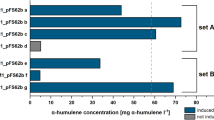Abstract.
A bicistronic reporter consisting of the promoterless genes aacC1 (conferring gentamycin resistance) and lacZ fused to the catabolic promoter of the phenol degradation genes was used to identify and analyse mutants of Pseudomonas putida with altered carbon catabolite repression (CR) of phenol degradation. Out of approximately 2500 mini-Tn5 mutants analysed so far, 12 mutants that were resistant to gentamycin during growth on succinate were identified. In eight of these mutants mini-Tn5 was inserted into one of the genes of the cyo operon. The cyo operon encodes the cytochrome o ubiquinol oxidase, the terminal oxidase of the cyanide-sensitive branch of the respiratory chain. In these mutants the activity of the P phlA promoter was significantly increased during growth on succinate and reached 15–20% of that found during growth with the non-repressing carbon source pyruvate. During growth on glucose the reduction of CR was less obvious, during growth on lactate CR was unchanged. The possible significance of the cyo operon for the generation of signal(s) for carbon catabolite repression is discussed.
Similar content being viewed by others
Author information
Authors and Affiliations
Additional information
Electronic Publication
Rights and permissions
About this article
Cite this article
Petruschka, .L., Burchhardt, .G., Müller, .C. et al. The cyo operon of Pseudomonas putida is involved in carbon catabolite repression of phenol degradation. Mol Gen Genomics 266, 199–206 (2001). https://doi.org/10.1007/s004380100539
Received:
Accepted:
Issue Date:
DOI: https://doi.org/10.1007/s004380100539




